Andrew and Scott are Australian community members with severe haemophilia A.
Australian brothers Andrew, 30 and Scott, 37, took on the El Capitan climb at Yosemite National Park in California in September 2019. Andrew is an HFA youth leader. HFA has been following their preparation and adventures on Factored In and our social media. Scott tells the story of their grand adventure.
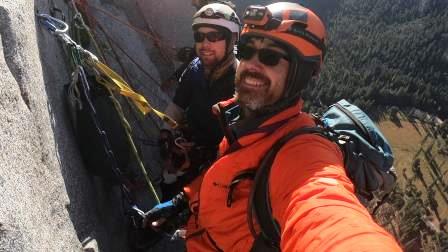
In September 2019 my brother Andrew and I travelled to California to pursue an audacious goal. It was one that we’d been working towards for months, and something that I’d been dreaming about for years. We wanted to climb a mountain called El Capitan, a 1000-metre-high granite monolith in Yosemite National Park, via the famous ‘Nose’ route, arguably the greatest rock climb in the world.
THE WALL

Andrew and Scott having breakfast on the wall
Photo: Scott and Andrew
The Nose of El Cap is the quintessential ‘big wall’, a huge vertical cliff too big to climb in one day, requiring specialised technical climbing skills, endurance and commitment. On paper, the Nose doesn’t sound that hard. The technical difficulty of the climbing is well within the capability of most competent climbers, but the sheer size of the wall, the complicated rope techniques required, the logistics involved in living on the side of a cliff for several days and the physical and psychological stamina required to keep going all add up to make it a serious undertaking. More than half of the climbers who start up the route turn around before making it a third of the way up the wall. Adding an extra dimension to the challenge was the fact that Andrew and I both have severe haemophilia.
In the months leading up to the trip we’d practiced the rope techniques and climbed some smaller routes to get our systems working smoothly. We’d also done our best to train to prepare for what I was fully expecting would be the hardest physical thing that either of us had ever done. For me, this training hadn’t gone very well. A series of injuries meant that I arrived in Yosemite feeling unfit and very anxious about how my body would hold up. My biggest fear was that the niggling back and shoulder injury that had been giving me trouble for weeks would develop into a bleed on the wall, necessitating a retreat from hundreds of metres above the ground.
THE CLIMB
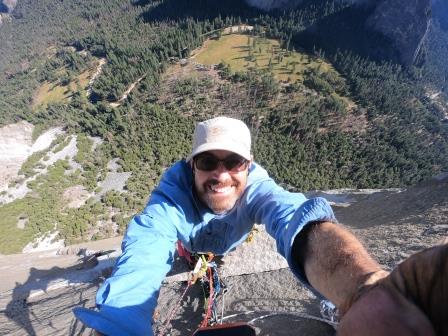
Scott on the side of El Capitan.
Photo: Scott and Andrew
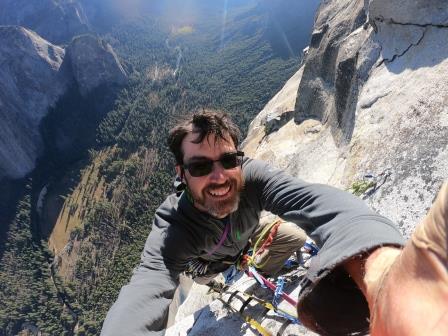
Scott on the Boot Flake, about halfway up El Capitan
Photo: Scott and Andrew
On our first attempt the climbing went smoothly enough, and physically we seemed to be doing OK, but the greatest rock climb in the world attracts climbers from everywhere, and the crowds were making things difficult. On our third day on the wall we found ourselves stuck at the back of a slow-moving convoy of four two-man teams, all chasing the same dreams of El Cap glory. We were still at the back of the queue when we reached one of the crux sections of the wall – the famous ‘King Swing’. This section, located about 600 metres above the ground, involves lowering 20 metres down then running wildly back and forth on the vertical wall, swinging on the rope to reach a crack system far off to the side. Even after having read dozens of stories and watching all the online videos I was totally unprepared for how difficult and committing this manoeuvre would be. I tried multiple times, but I kept coming up short of the hold I was aiming for. On each one of these failed attempts, gravity would take over and send me swinging back across the wall at high speed. On one of these return swings I crashed awkwardly back into the rock, and felt a jarring pain in my hip and ankle. Luckily the climbers just in front of us were able to throw me a line so that I could pull myself across the swing, but with the painful hip I only managed two more rope lengths of climbing before throwing in the towel. After a long and involved retreat we found ourselves back on the ground, full of mixed feelings and wondering if we’d made the right decision to come down.
After a few days of rest and easier climbing my hip recovered and we started thinking about another attempt. The weather forecast looked less than ideal, with cold temperatures and possible snow, but we decided to take a chance and go anyway. Our plan this time was to avoid the King Swing by climbing a variation called the Jardine Traverse that weaved around to the left for about 100 vertical metres before re-joining the original route at the point we had retreated from last time.
I started to question the wisdom of our gamble with the weather while dangling 50 metres above the ground at 3 am on the first morning, being buffeted by freezing rain and wind. It soon cleared though and we found the wall that had been so crowded before was almost totally empty. Without the pressure of other teams on the route we could relax and enjoy the amazing climbing at our own pace.
On our second morning we reached the spot that we had bailed from before and kept climbing into new terrain. Above this point the wall gets steeper and the feeling of exposure from having so many hundreds of metres of air between us and the ground was exhilarating. We kept moving methodically up the wall one rope length at a time, following the same process over and over. Climb, fix rope, haul the bag, ascend the fixed line, climb, fix rope, haul the bag, ascend the fixed line. We had found the rhythm of the wall and we knew that this time we were going to make it to the top. With each pitch of climbing all the stress and anxiety about lack of fitness, and all the doubts and questions about whether we were good enough to be there faded further away. As we gained height the views of Yosemite valley gradually extended outwards to include more and more distant horizons. Then, on the afternoon of our fifth day we pulled over the top, and suddenly the vertical world that we had been living in shifted back to the horizontal.
THE SUMMIT
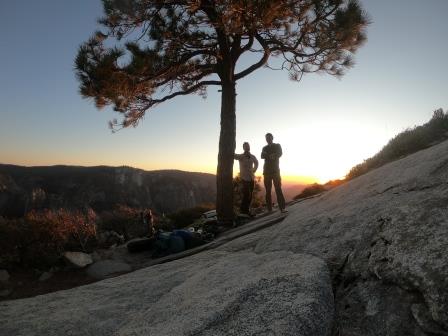
Andrew and Scott at the famous tree at the top of the Nose.
Photo: Scott and Andrew
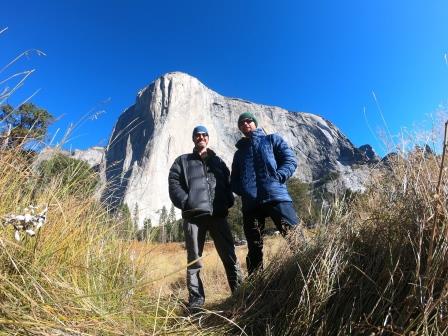
Victory photo after climbing El Cap
Photo: Scott and Andrew
The last evening that we spent camped on the summit of El Cap was one of the best nights I can remember. We gazed out at the stars above the valley while we feasted on the last of our beef jerky, chocolate and freeze-dried rice and vegetables. I don’t think anything had ever tasted so good. As I crawled into my smelly sleeping bag that night, I felt sore and tired, but profoundly satisfied.
We hope that by sharing this story we might inspire others with bleeding disorders to pursue their own big and physically challenging goals, whatever they may be. By climbing El Capitan Andrew and I proved to ourselves that haemophilia doesn’t have to be a barrier to achieving something hard, and found out that we’re capable of more than we suspected.
Scott and Andrew used their climbing challenge to fundraise for HFA. You can show your support of Scott and Andrew’s efforts by donating at https://give.everydayhero.com/au/climbing-el-capitan-with-haemophilia
Haemophilia Foundation Australia acknowledges the Traditional Owners and Custodians of Country throughout Australia, the land, waters and community where we walk, live, meet and work. We pay our respects to Elders past and present and extend that respect to all Aboriginal and Torres Strait Islander peoples.
Sign up for the latest news, events and our free National Haemophilia magazine